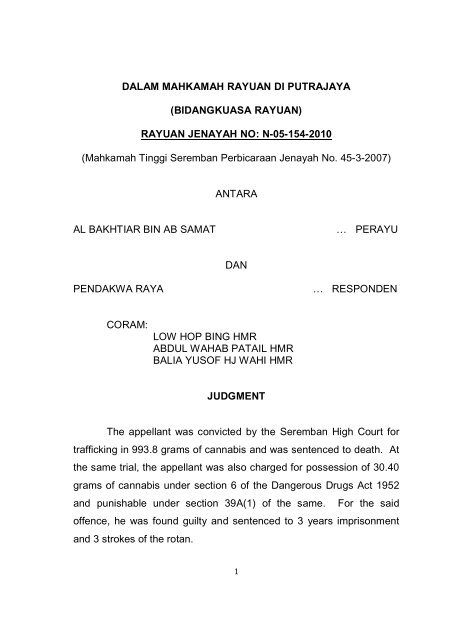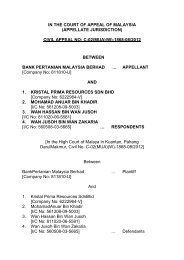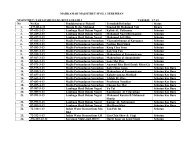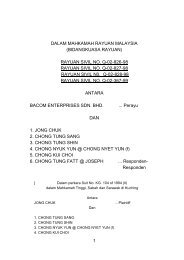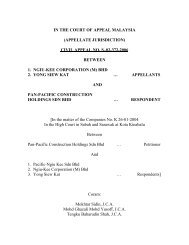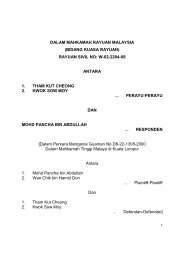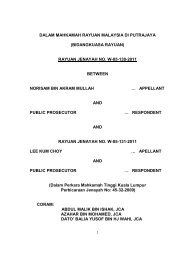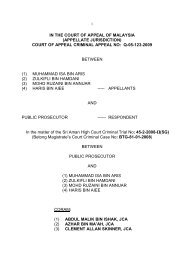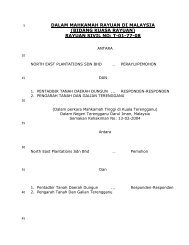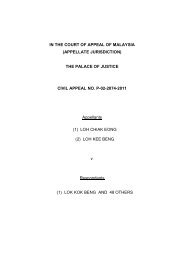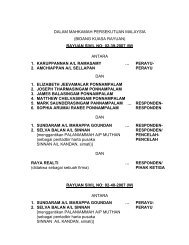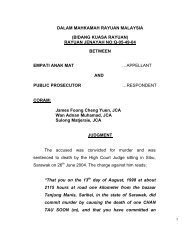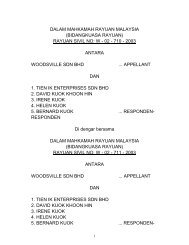RAYUAN JENAYAH NO: N-05-154-2010
RAYUAN JENAYAH NO: N-05-154-2010
RAYUAN JENAYAH NO: N-05-154-2010
Create successful ePaper yourself
Turn your PDF publications into a flip-book with our unique Google optimized e-Paper software.
DALAM MAHKAMAH <strong>RAYUAN</strong> DI PUTRAJAYA<br />
(BIDANGKUASA <strong>RAYUAN</strong>)<br />
<strong>RAYUAN</strong> <strong>JENAYAH</strong> <strong>NO</strong>: N-<strong>05</strong>-<strong>154</strong>-<strong>2010</strong><br />
(Mahkamah Tinggi Seremban Perbicaraan Jenayah No. 45-3-2007)<br />
ANTARA<br />
AL BAKHTIAR BIN AB SAMAT … PERAYU<br />
DAN<br />
PENDAKWA RAYA … RESPONDEN<br />
CORAM:<br />
LOW HOP BING HMR<br />
ABDUL WAHAB PATAIL HMR<br />
BALIA YUSOF HJ WAHI HMR<br />
JUDGMENT<br />
The appellant was convicted by the Seremban High Court for<br />
trafficking in 993.8 grams of cannabis and was sentenced to death. At<br />
the same trial, the appellant was also charged for possession of 30.40<br />
grams of cannabis under section 6 of the Dangerous Drugs Act 1952<br />
and punishable under section 39A(1) of the same. For the said<br />
offence, he was found guilty and sentenced to 3 years imprisonment<br />
and 3 strokes of the rotan.<br />
1
The Prosecution’s case<br />
On 8 July 2006 at about 8.30 pm, Chief Inspector Hafiz (SP7)<br />
together with SP5, SP1 and his men went to Kg Jati on a crime<br />
prevention round against drug trafficking. They took up ambush<br />
position at the road side and about 10 minutes later SP7 and SP5 saw<br />
a male person approaching on a motorcycle. The said male person<br />
was later identified as the appellant. The appellant was stopped by<br />
SP5 who then carried out a body search and found from the<br />
appellant’s right jeans pocket a small black pouch. On further<br />
examination, SP5 found 5 plastic packets containing dried plant<br />
materials suspected to be cannabis. This formed the subject of the<br />
charge under section 6 of the Dangerous Drugs Act 1952 against the<br />
appellant.<br />
The appellant was taken to the Kuala Pilah police station and<br />
was later interrogated by SP7. Resulting from the interrogation, the<br />
appellant then led SP7 and his men to a house no. 19A Kg Parit<br />
Seberang (hereinafter referred to as the “said house”) with his hand<br />
cuffed to the back. Inside the house were the appellant’s adopted<br />
sister (SP3) and his mother (now deceased) and his grandmother.<br />
The appellant then showed a room to the police party. It was closed.<br />
SP7, SP5 and the appellant who was guarded by L/kpl Azhar entered<br />
the room. Upon entering the said room, both SP7 and SP5 could<br />
sense a strong smell of ganja. The appellant indicated he wanted to<br />
show something and SP7 instructed L/kpl Azhar to change the<br />
appellant’s handcuff from back to the front. The appellant then pointed<br />
to a cupboard and from among the clothes took out a block of dried<br />
2
plant material wrapped in a transparent plastic and handed it over to<br />
SP7. The appellant then took out a red plastic container from<br />
underneath a table and also handed it over to SP7. Inside the plastic<br />
container an aluminum package containing a block of dried plant<br />
materials suspected to be cannabis was found.<br />
Analysis by the government chemist (SP4) confirmed that the<br />
block of dried plant materials recovered from the room were cannabis,<br />
993.8 grams in weight.<br />
At the end of the prosecution’s case the learned trial judge<br />
found a prima facie case was established against the appellant and<br />
called upon him to enter his defence.<br />
The defence case<br />
In his defence, the appellant gave evidence on oath and called<br />
4 other witnesses. The appellant disputed the version given by the<br />
prosecution. He never handed over the cannabis to the police. The<br />
police ransacked the room and found the drugs in the cupboard and<br />
from underneath the table. He has no knowledge about the drugs and<br />
that others had access to his room namely his cousin Aboy and his<br />
uncle Kamil. The details of the appellant’s defence has been fully set<br />
out by the learned trial judge at pages 34 – 35 of the Appeal Record.<br />
The other 4 defence witnesses gave evidence to the fact that<br />
the appellant’s uncle, Kamil also stays in the house and that he was a<br />
confirmed drug addict. Aboy, the cousin has a free access to the room<br />
3
as he was very close with the appellant. SD2, an officer from the<br />
Pusat Serenti confirmed that Kamil was a drug addict and an inmate at<br />
the Pusat Serenti while SD3 and SD4 were the appellant’s siblings and<br />
SD5 the appellant’s other uncle. The evidence of SD3, SD4 and SD5<br />
states that Kamil stays in the same house and Aboy who is very close<br />
to the appellant has a free access to the house and the room where<br />
the drugs were found. Kamil has passed away and Aboy has<br />
disappeared after the appellant’s arrest.<br />
The trial judge’s decision<br />
At the end of the defence case, the trial judge held that in<br />
essence the defence is one of bare denial and an afterthought. The<br />
appellant was found guilty, convicted and was sentenced to death for<br />
the offence of trafficking in 993.8 grams of cannabis. Hence this<br />
appeal.<br />
The Appeal<br />
Before us, learned counsel for the appellant raised two main<br />
grounds of appeal which are as follows:<br />
a) That the learned trial judge misdirected himself when he<br />
failed to appreciate the defence case; and<br />
b) That the learned trial judge misdirected himself when his<br />
Lordship acted on the evidence of the first charge as<br />
similar fact evidence to prove knowledge in respect of the<br />
trafficking charge.<br />
4
In support of the first ground, learned counsel argued that the<br />
trial judge erred in holding the appellant’s defence as an afterthought<br />
and a bare denial. Counsel submitted that the trial judge has erred in<br />
failing to appreciate that the appellant in his defence has challenged<br />
the prosecution’s version of events that took place in the house. The<br />
appellant further complained of the trial judge’s comment on the<br />
defence failure to call a certain witness and in invoking section 114(g)<br />
of the Evidence Act against him.<br />
The appellant’s challenge on the prosecution’s version of<br />
events that took place was taken during the cross-examination of SP5,<br />
SP7 and SP8. In his written submission, learned counsel has referred<br />
to us the specific challenges made to these witnesses as follows:<br />
“Challenges by the appellant on SP5’s evidence:<br />
(i) At pg 25 of the Appeal Record<br />
“S: Bila masuk bilik itu awak terus arah anggota gelidah<br />
bilik itu.<br />
J: Tak setuju.”<br />
(ii) At pg 27 of the Appeal Record<br />
“S: Saya katakan kepada awak barang salah yang dikata<br />
diserah oleh OKT sebenarnya barang salah yang<br />
dijumpai hasil penggelidahan dalam rumah<br />
khususnya dalam bilik tersebut.<br />
J: Tak setuju.”<br />
5
(iii) At pg 30 of the Appeal Record<br />
“S: OKT tidak pernah pada mana-mana masa<br />
mengeluarkan apa-apa barang dan menyerahkan<br />
kepada Insp. Hafiz pada malam tersebut.<br />
J: Tak setuju.”<br />
(iv) At pg 32 of the Appeal Record<br />
“S: Awak tidak bercakap benar tentang:<br />
1) Bagaimana serbuan dijalankan<br />
2) Bagaimana barang salah dijumpai dalam rumah.<br />
J: Tidak setuju.”<br />
Challenges to the evidence of SP7:<br />
(i) At pg 41of the Appeal Record with regard to the search<br />
list (Ex. P22):<br />
“S: Awak tidak masukkan barang kes ini dijumpai oleh<br />
sesiapa sebab barang kes dijumpai oleh anggota<br />
awak.<br />
J: Tidak setuju.”<br />
(ii) At pg 43 of the Appeal Record<br />
“S: Ketika sampai di rumah OKT awak dan anggota terus<br />
buat penggelidahan.<br />
J: Tak setuju.”<br />
(iii) At pg 44 of the Appeal Record<br />
“S: Setelah awak dan anggota menggelidah barulah<br />
awak dan anggota menjumpai barang salah.<br />
6
J: Tak setuju.<br />
S: Keterangan awak tentang gari dan juga apa yang<br />
berlaku dalam bilik tidak benar.<br />
J: Tak setuju.<br />
Challenge to the evidence of the Investigating Officer (SP8):<br />
“S: Barang-barang salah yang dijumpai adalah hasil<br />
serbuan dan penggelidahan anggota dalam rumah<br />
itu.<br />
J: Tak setuju.”<br />
From the above transcriptions it seems clear to us that the<br />
challenge put forth by the appellant was in respect of how the<br />
impugned drugs were recovered from the room. The appellant’s<br />
version is that the police party ransacked his room and found the drugs<br />
themselves. It is also part of his defence that he did not bring the<br />
police party to his room, instead he was taken there.<br />
We are of the view that the appellant’s cross-examination of<br />
SP5, SP7 and SP8 and putting to these witnesses his version is part of<br />
the process of his defence. What the appellant did was merely<br />
exercising his legitimate right and duty of advancing his defence during<br />
the prosecution’s case itself. He crystallised the said defence as<br />
evidence during the defence stage when he together with SD2, SD3,<br />
SD4 and SD5 gave evidence. In our view, the defence put forth by the<br />
appellant is not a bare denial and certainly far from being an<br />
afterthought. We disagree with the learned trial judge.<br />
7
follows:<br />
In Tan Kim Ho & Anor v. PP (2009) 3 CLJ 236, it was held as<br />
“In our adversarial system of justice, the duty of each party is to<br />
show that his case is the truth. This is done by him adducing his own<br />
witnesses to support his contention. When it is the Plaintiff or<br />
prosecutor who is adducing the evidence, his witnesses are subject to<br />
cross-examination by the defence or the accused person. When a<br />
prosecution witness makes a statement of fact which is disagreed to by<br />
the defence it becomes the defence’s duty to, in whatever way, put to<br />
the Plaintiff or prosecution witness that what the witness has said is not<br />
true. In addition, he could also use the Plaintiff’s or prosecution’s<br />
witnesses to adduce evidence to support his defence and to indicate<br />
what his defence is. This he is required to do to enable the Plaintiff or<br />
prosecution to bring out evidence to disprove what the defence intends<br />
to adduce. If the defence does not in any way indicate by crossexamination<br />
of those facts those statements made by the Plaintiff’s or<br />
prosecution’s witnesses must be accepted as true. Even if the<br />
Plaintiff’s or prosecution’s witness does not say anything relating to the<br />
defence case, it is still the duty of the defence to bring out his case<br />
during the Plaintiff’s or prosecution’s case.”<br />
The appellant’s defence was that he did not know about the<br />
drugs found in the room. The room is accessible to at least 2 or 3<br />
other persons. The drugs could have been placed there by these other<br />
persons or could have belonged to his uncle Kamil, a confirmed drug<br />
addict. The accessibility of the room to these other persons was<br />
brought up when SP3 and SP8 were cross-examined (Pages 9 – 10<br />
and 55 of the Appeal Record. Clearly, the defence is not an<br />
afterthought.<br />
In his judgment, the learned trial judge found that certain facts<br />
were never put or suggested by the defence during the prosecution’s<br />
8
case. They only surfaced during the defence. Hence his Lordship<br />
held them to be afterthoughts. These facts are adumbrated in<br />
paragraphs a – i of his Lordship’s judgment at pages 135 – 141 of the<br />
Appeal Record. We do not deem it necessary to reproduce those<br />
matters here but suffice to say that even if they are “afterthoughts” as<br />
the learned trial judge has found them to be, they do not in any way<br />
help bolster the defence case and neither do they strengthen the<br />
prosecution’s case.<br />
In further support of his contention that the trial judge has<br />
misdirected himself in failing to appreciate the defence case, learned<br />
counsel submits that the trial judge has failed to consider the evidence<br />
of SD2 – SD5 which supports the appellant’s version and defence that<br />
he was not in exclusive control of the room where the drugs were<br />
found and the drugs could have been placed there or belonged to<br />
others who had access to the room.<br />
We agree with the learned counsel’s submission that the<br />
learned trial judge did not consider and appraise the evidence of these<br />
defence witnesses. In paragraph 25 of his Lordship’s ground of<br />
judgment (pages 129 – 130 of the Appeal Record) a summary of the<br />
appellant’s evidence was tabulated but nowhere else do we find his<br />
Lordship’s consideration of the other defence witnesses’ evidence. To<br />
use the learned counsel’s words, “his Lordship brushed it aside without<br />
sufficient consideration”. To illustrate his point, learned counsel cited a<br />
passage from the judgment at pages 142 – 143 of the Appeal Record<br />
where his Lordship said:<br />
9
“Pihak pembelaan cuba menunjukkan bahawa kawan-kawan<br />
OKT bebas masuk ke dalam bilik OKT yang tidak pernah<br />
berkunci itu bagi mewujudkan fakta bahawa mungkin dadah itu<br />
milik orang lain atau dadah itu disimpan di dalam bilik OKT<br />
tanpa pengetahuan OKT oleh orang lain. Pada pandangan<br />
Mahkamah kemungkinan-kemungkinan yang cuba diwujudkan<br />
ini bukan suatu “reasonable doubt” kerana kes pendakwaan<br />
adalah OKT yang menunjukkan tempat ia menyimpan dan<br />
mengambil sendiri dadah itu.”<br />
We found the trial judge did not at all address his mind to the<br />
evidence of SD2, SD3, SD4 and SD5. This is a misdirection.<br />
We are in agreement with the learned counsel’s submissions.<br />
The Federal Court in Lee Ing Chin v. Gan Yook Chin (2003) 2 MLJ<br />
97 has set out what judicial appreciation of evidence means. It said:<br />
“A judge who is required to adjudicate upon a dispute must<br />
arrive at his decision on an issue of fact by assessing, weighing<br />
and, for good reasons, either accepting or rejecting the whole<br />
or any part of the evidence placed before him. He must, when<br />
deciding whether to accept or to reject the evidence of a<br />
witness, test it against relevant criteria. Thus, he must take into<br />
account the presence or absence of any motive that a witness<br />
may have in giving his evidence. If there are contemporary<br />
documents, then he must test the oral evidence of a witness<br />
against these. He must also test the evidence of a particular<br />
witness against the probabilities of the case. A trier of fact who<br />
makes findings based purely upon the demeanour of a witness<br />
without undertaking a critical analysis of that witness’s evidence<br />
runs the risk of having his findings corrected on appeal. It does<br />
not matter whether the issue for decision is one that arises in a<br />
civil or criminal case: the approach to judicial appreciation of<br />
evidence is the same.”<br />
10
Again, in Tindok Besar Estate Sdn Bhd v. Tinjar Co. (1979) 2<br />
MLJ 229, Chang Min Tat FJ at page 234 reiterated:<br />
“Judicial reception of evidence requires that the oral evidence<br />
be critically tested against the whole of the other evidence and<br />
the circumstances of the case. Plausibility should never be<br />
mistaken for veracity.”<br />
Finally, we would also echo the words of Gopal Sri Ram JCA<br />
(as he then was) in Boonsoom Boonyumit v. Adorna Properties<br />
Sdn Bhd (1937) 3 CLJ wherein his Lordship had stated:<br />
“… a trier of facts, in order to arrive at a decision according to<br />
law, must judicially appreciate the evidence led before him<br />
upon the issue called for resolution. A decision arrived in<br />
absence of a judicial appreciation of evidence is liable to judicial<br />
correction. Judicial appreciation is concerned with the process<br />
of evaluating the evidence for the purpose of discovering where<br />
the truth lies in a particular case. It includes, but is not limited<br />
to, identifying the nature and quality of evidence, assigning<br />
such weight to it as trier of fact deems appropriate, testing the<br />
credibility of oral evidence against contemporaneous<br />
documents as well as the probabilities of the case and<br />
assessing the demeanour of witnesses.”<br />
Our perusal of the records do not suggest that there has<br />
been any attempt on the part of the trial judge to critically examine the<br />
evidence of those defence witnesses called by the appellant to support<br />
his case. This merits our intervention and the learned trial judge’s<br />
decision is liable to judicial correction.<br />
11
Section 114(g) of the Evidence Act 1950<br />
The drawing of an adverse inference by the learned trial judge<br />
under section 114(g) of the Evidence Act 1950 on the failure of the<br />
defence to call L/Kpl Azhar is according to the learned counsel<br />
prejudicial to the appellant. We agree with the learned counsel that at<br />
page 139 of the Appeal Record the learned trial judge did comment on<br />
that failure of the defence. In his evidence, the appellant stated that<br />
Koperal Idurs (SP5) was the police personnel who escorted him and<br />
not L/Kpl Azhar. This was only brought up by the appellant when he<br />
gave evidence in his defence and was never raised during the<br />
prosecution’s case when SP7 or SP5 was giving evidence. His<br />
Lordship held this was an afterthought and went further to say that the<br />
defence should have called L/Kpl Azhar who was later offered to the<br />
defence. Looking at the factual matrix of the case and having given<br />
our anxious consideration of that comment made by the learned trial<br />
judge, we do not think that the learned trial judge draw any adverse<br />
inference against the appellant’s failure as alleged. But we are<br />
satisfied that his Lordship did comment on the failure which we think is<br />
really unnecessary and uncalled for. Perhaps, it would be timely for us<br />
to remind trial judges of the words of Raja Azlan Shah J (as His<br />
Majesty then was) in Tan Foo Su v. PP (1967) 2 MLJ 19 which goes:<br />
“It is not the duty of an accused person to prove his innocence,<br />
far less to produce or to bring a particular witness to support his<br />
story. Failure of the defence to produce a particular witness<br />
must not be made the subject of adverse comment by the court<br />
otherwise it would amount to a misdirection.”<br />
12
Similar Fact Evidence<br />
At page 32 of the judgment (pg 127 of the Appeal Record), the<br />
learned trial judge held that the fact that the appellant was arrested in<br />
respect of the 30.40 grams of cannabis found on him earlier, attracts<br />
the application of section 15 of the Evidence Act 1950. These facts<br />
according to the learned trial judge impute knowledge of the appellant.<br />
The relevant part of his Lordship’s judgment is appended below:<br />
“Fakta bilik tersebut berbau Kanabis dan OKT ditangkap<br />
sebelum ini dengan Kanabis seberat 30.40 gram membolehkan<br />
“similar facts evidence” di bawah Seksyen 15 Akta Keterangan<br />
1950 digunapakai. Kesemua fakta kes ini merangkumi<br />
kelakuan OKT dan pengetahuan OKT akan kedudukan sebenar<br />
semua Kanabis seberat 993.8 gram tersebut bukanlah satu<br />
kebetulan sebaliknya OKT sememangnya mengetahui akan<br />
kewujudan Kanabis di dalam biliknya sendiri.”<br />
Learned counsel for the appellant took objection to this and<br />
submitted that the learned trial judge has misdirected himself in two<br />
aspects, namely:<br />
a) Firstly, the first charge against the appellant is for<br />
possession of 30.40 grams of cannabis while the second<br />
charge is for trafficking and strictly speaking there is no<br />
similarity in respect of both the charges; and<br />
b) Secondly, even if there is similarity, the trial judge before<br />
acting on the similar fact evidence must undertake a<br />
weighing exercise and ask whether the prejudicial effect of<br />
13
that similar fact evidence would be outweighed by its<br />
probative value.<br />
For ease of reference we append the relevant provisions of<br />
sections 14 and 15 of the Evidence Act 1950, minus the illustrations:<br />
“14. Facts showing the existence of any state of mind, such<br />
as intention, knowledge, good faith, negligence,<br />
rashness, ill-will or good-will towards any particular<br />
person, or showing the existence of any state of body or<br />
bodily feeling is in issue or relevant.<br />
15. When there is a question whether an act was accidental<br />
or intentional or done with a particular knowledge or<br />
intention, the fact that the act formed part of a series of<br />
similar occurrences, in each of which the person doing<br />
the act concerned, is relevant.”<br />
The principle of law relating to similar fact evidence as laid<br />
down in Makin v. AG for New South Wales (1894) AC 57 may<br />
summarily be stated as follows:<br />
“(1) It is undoubtedly not competent for the prosecution to<br />
adduce evidence tending to show that the accused has<br />
been guilty of criminal acts other than those covered by<br />
the indictment, for the purpose of leading to the<br />
conclusion that the accused is a person likely from his<br />
criminal conduct or character to have committed the<br />
offence for which he is being tried; and<br />
(2) … the mere fact that the evidence adduced tends to<br />
show the commission of other crimes does not render it<br />
inadmissible if it be relevant to an issue before the jury,<br />
14
and it may be so relevant if it bears upon the question<br />
whether the acts alleged were designed or accidental, or<br />
to rebut a defence which would otherwise be open to the<br />
accused.”<br />
In support of his submission, learned counsel referred to us the<br />
case of Junaidi b. Abdullah v. PP (1993) 3 MLJ 217 where at page<br />
226 – 227 Mohamed Azmi SCJ said:<br />
“On the principle laid down in Makin’s case and Boardman’s<br />
case, we are of the opinion that where the purpose of adducing<br />
evidence of similar facts or similar offences is justifiable on the<br />
ground of relevancy and necessity to rebut and defence which<br />
would otherwise be open to the accused (in addition to thoses<br />
under ss 14 and 15 of the Evidence Act 1950), it is admissible<br />
in evidence provided the probative value of such evidence out<br />
weighs its prejudicial value. There must be a real anticipated<br />
defence to be rebutted and not merely ‘crediting the accused<br />
with a fancy defence’ as emphasized by the Privy Council in<br />
Noor Mohamed v R at pg 192.”<br />
In Azahan b. Mohd. Aminallah v. Public Prosecutor (2004) 6<br />
AMR 810, the accused was charged with raping a 15 year old girl. The<br />
prosecution in the course of the trial had adduced prejudicial similar<br />
fact evidence of previous acts of sexual intercourse. Gopal Sri Ram<br />
JCA (as he then was) speaking on the admissibility of similar fact<br />
evidence has the following to say at pages 821 – 822 of the report:<br />
“A court when deciding whether to admit similar fact<br />
evidence must carry out a balancing exercise by weighing the<br />
probative value of such evidence against its prejudicial effect as<br />
impliedly required by ss 14 and 15 of the Evidence Act 1950.<br />
The court would be justified in admitting the evidence where its<br />
15
probative value is outweighed by its prejudicial effect. See,<br />
Boardman v Director of Public Prosecutions {1975] AC 421,<br />
Director of Public Prosecutions v PP [1991] 2 AC 447; Junaidi b<br />
Abdullah v PP [1993] 2 AMR 2209; [1993] 3 MLJ 217; PP v.<br />
Teo Ai Nee [1995] 2 SLR 69; Tan Meng Jee v PP [1996] 2 SLR<br />
422; Lee Kwang Peng v PP [1997] 3 SLR 278. In Tan Meng<br />
Jee v PP, Yong Pung How CJ when delivering the judgment of<br />
the Singapore Court of Appeal said of the equipollent provisions<br />
in the Singapore Evidence Act:<br />
Be that as it may, we are of the opinion that the admission<br />
of similar fact evidence, at least for the purposes identified in ss<br />
14 and 15 of the Evidence Act, should be governed by the<br />
balancing test adopted by the House of Lords in Boardman’s<br />
case. Such an approach is warranted both in principle as well<br />
as on the wording of the legislation itself. As to the former, it<br />
has been argued above that the rationale of the rule excluding<br />
similar fact evidence is so that every person charged with an<br />
offence may only be convicted upon being proved to have<br />
committed the acts within the charge. It would be subverting<br />
established jurisprudence to allow a conviction based on the<br />
particular disposition of the accused – based on the contention<br />
that the accused is that type of person who would commit such<br />
an offence. On the other hand, there may be cases where the<br />
interest of justice clearly outweigh any prejudicial dangers<br />
inherent in the evidence. With respect we entirely agree with<br />
the aforesaid dictum, coming as it does from so authoritative a<br />
source as His Honour the Chief Justice of Singapore. Further,<br />
like His Honour, we also find illustration (o) to s 14 of the<br />
Evidence Act 1950 to be relevant. That illustration reads:<br />
A is tried for the murder of B by intentionally shooting him<br />
dead. The fact that A on other occasions shot at B is<br />
relevant as showing his intention to shoot B. The fact that<br />
A was in the habit of shooting at people with intent to<br />
murder them is irrelevant.<br />
16
So, here too, PW2’s evidence as to the appellant’s<br />
previous acts of intercourse with her was relevant, that is to<br />
say, admissible. But that does not, on the authorities we have<br />
cited, relieve the court of determining whether the probative<br />
value of her evidence outweighed its prejudicial effect. We<br />
have carefully examined the record and nowhere in the<br />
judgment of the Sessions Court is there the kind of balancing<br />
exercise dictated by ss 14 and 15 of the Evidence Act. This is<br />
a serious misdirection. It occasioned a serious miscarriage of<br />
justice as the Sessions Court acted on the similar fact evidence<br />
to add three further charges against the appellant.”<br />
We too have carefully examined the records of appeal before<br />
us and nowhere do we find in the judgment of the learned trial judge<br />
the kind of balancing exercise as dictated by sections 14 and 15 of the<br />
Evidence Act before admitting the similar fact evidence against the<br />
appellant. Again, this is a misdirection.<br />
Before leaving the issue, it is pertinent to address the point<br />
raised by the learned counsel namely on the similarity of the two<br />
offences or charges against the appellant.<br />
On this issue of whether there is similarity between the offence<br />
of possession of 30.40 grams of cannabis for which the appellant was<br />
arrested earlier and charged and the present charge of trafficking in<br />
993.8 grams of the same drug and whether similarity of the offences is<br />
a prerequisite, we can do no better than by referring to the case of<br />
Public Prosecutor v. Mohamad Roslan bin Desa [Mahkamah<br />
Persekutuan Rayuan Jenayah No. <strong>05</strong>-28-2007(K)].<br />
17
In the said case, the respondent was charged for the offence of<br />
murder under s. 302 of the Penal Code on 28 December 1998. During<br />
the trial before the High Court, the prosecution attempted to introduce<br />
the record of proceedings in the Sessions Court where the respondent<br />
had pleaded guilty to an offence under s. 304(b) of the same code<br />
which was committed on 11 December 1998. The High Court has<br />
rejected the evidence on the ground that there is no similarity between<br />
the two cases against the respondent. On appeal to the Federal Court<br />
by the Public Prosecutor, one of the grounds raised was similar fact<br />
evidence. The Federal Court, in a judgment delivered by Arifin b.<br />
Zakaria (HBM as he then was) stated the following as the proper test<br />
for the admission of similar fact evidence:<br />
“The Courts below rejected the similar fact evidence on the<br />
basis that there was no striking similarity between what<br />
happened in the earlier case and the present case. It should<br />
perhaps be noted that the House of Lords in DPP v P had<br />
retracted from the test laid down in Boardman as to the<br />
requirement of “striking similarity” and said that it was<br />
inappropriate to single out “striking similarity” as an essential<br />
element in every case. But following Boardman it was held<br />
that the essential feature of admissibility of such evidence is<br />
whether its probative force in support of the charge is<br />
sufficiently great to make it just to admit the evidence<br />
notwithstanding that its prejudicial effect on the accused<br />
tending to show that he was guilty of another offence. Whether<br />
the evidence has sufficient probative value to outweigh its<br />
prejudicial effect must in each case be a question of degree.<br />
The test has since been authoritatively laid down in DPP v P in<br />
terms of probative value as against its prejudicial effect. There<br />
is force in saying that the decision in DPP v P is in line with ss<br />
14 and 15 of the Evidence Act as “striking similarity” has never<br />
been a requirement of the said sections.”<br />
18
We also find it useful to recall the words of Scarman LJ in R v.<br />
Scarrot (1978) QB 1016 on this issue of similarity of facts:<br />
“Positive probative value is what the law requires, if similar fact<br />
evidence be admissible. Such probative value is not provided<br />
by the mere repetition of similar facts; there has to be some<br />
feature or features in the evidence sought to be adduced which<br />
provides a link, an underlying link as it has been called in some<br />
of the cases. The existence of such a link is not to be inferred<br />
from mere similarity of facts which are themselves so<br />
commonplace that they can provide no sure ground for saying<br />
that they point to the commission by the accused of the<br />
offence under consideration.”<br />
The authorities are clear that the similarity test is not a<br />
prerequisite for the admission of similar fact evidence.<br />
We sum up by saying that this is a case which is riddled with a<br />
number of unsatisfactory features. We are of the unanimous view that<br />
it is unsafe to uphold the conviction recorded against the appellant.<br />
The appeal is allowed and we set aside the conviction and sentence<br />
on the trafficking charge. The appellant is hereby acquitted and<br />
discharged.<br />
sgd<br />
DATO’ BALIA YUSOF BIN HJ WAHI<br />
Judge Court of Appeal Malaysia<br />
Dated : 5 March 2012<br />
19
Parties:<br />
For the Appellant : Hisyam Teh Poh Teik<br />
Tetuan Teh Poh Teik & Co.<br />
For the Respondent: Siti Rafidah bt Zainuddin<br />
Timbalan Pendakwa Raya<br />
Jabatan Peguam Negara<br />
Malaysia<br />
20


